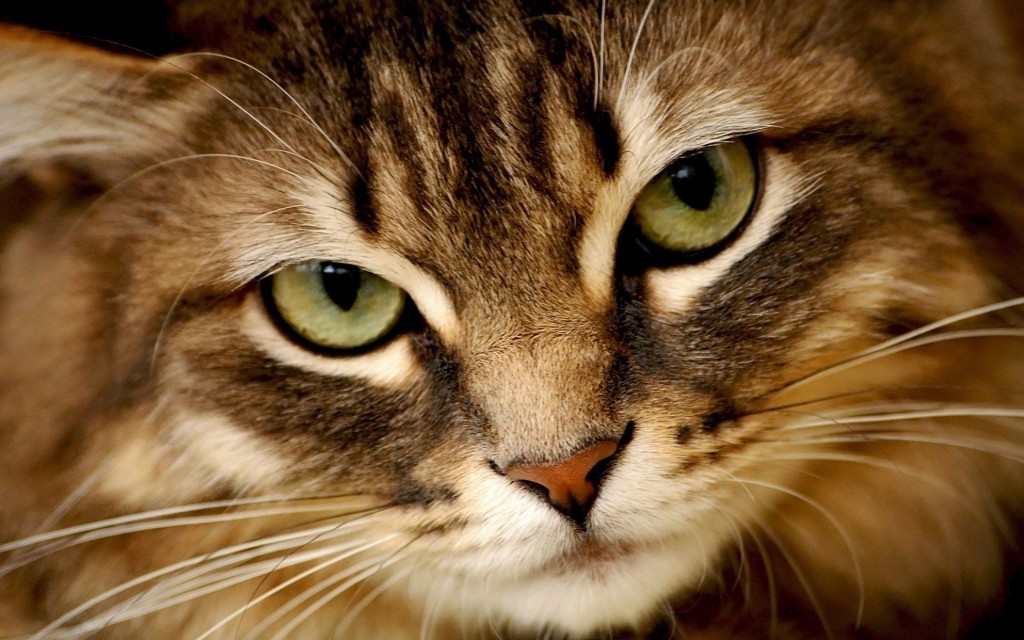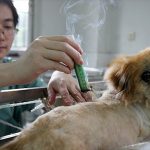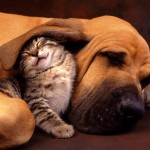Kidney Disease: Is There Any Hope? Yes there is!

In Chinese Medicine the kidneys are considered “The Batteries of the Body.” It is where the Vital Essence is stored. This Essence rules birth, development, and maturation. The ancient text Nan Jing states “The Kidneys are the mansion of Fire and Water, the residence of Ying and Yang … the channel of death and life.”
Veterinarians will tell you an animal can develop chronic kidney disease (CKD) at any age, but it is most common in older pets. And, it is more commonly seen in cats. It is estimated that 80% of the geriatric cat population will die of CKD, and that CKD increases 1.0% to 3.0% with age.
The kidneys are made up of microscopic nephrons (a complex system of tubules). As your cat or dog gets older, or the kidneys are damaged, some nephrons begin to die and the reserved nephrons will take over. Gradually over months, or even years, most of the reserved nephrons will be gone. At this point, the cat/dog may begin to show signs of kidney failure, such as, increased thirst and urination (and in some cases, deceased urination), vomiting, and gradual weight loss. Unfortunately, by the time most pet owners notice the symptoms there has already been 70% to 80% lost of kidney function. It is a disease that is very good at hiding itself because of the kidneys ability to compensate while it slowly loses function.
Diagnosing Kidney Disease
The veterinarian will run a complete blood chemical profile which will include a complete blood count (CBC) and an urinalysis to examine whether the kidneys are recycling water normally or not. The vet may do x-rays, or an ultrasound, to look for any abnormalities. For example, a smaller-than-normal sized kidney is another sign of kidney disease.
Animals with kidney disease may also be anemic, have high blood pressure, abnormal electrolyte levels, and high levels of creatinine and blood urea nitrogen (BUN).
There are four stages of kidney disease: Stage I, II, III, and IV, with Stage IV being the most severe. The vet will determine the Stage by the amount of blood waste products and other problems that are found in the urine.
Obviously, Stage I is easier to handle than Stage IV and catching the disease as early as possible will help your pet live a longer and comfortable life. However, the Catch-22 is, the above diagnosis procedures, including the BUN/creatinine analysis, won’t detect the disease before there is “70% to 80%” kidney damage. But, there is now good news: A new procedure called symmetric dimethylarginine, or the SDMA blood test, is more sensitive and can detect abnormalities when there is only 25% kidney damage. Plus, SDMA is much less affected by dehydration and protein loss than BUN and creatinine.
Update: A newer procedure to SDMA is RenalTech, a diagnostic tool created by Mars, Inc. The company claims it can predict renal failure in cats two years before the onset of symptoms. They also claim the tool is 95% accurate. You can learn more about it here.
Kidneys & Traditional Chinese Medicine
The best way Chinese Medicine understands the inner workings of the body is in the metaphor of the “cooking pot suspended over fire,” or the Triple Burner. The bottom third of the pot, the Lower Burner, is where the gall bladder resides. The middle, or the Middle Burner, is the stomach, and the upper third half, or the Upper Burner, is the spleen, liver, heart, and the top of the pots lid are the lungs. But, it’s the fire underneath the pot where the kidneys sit. The Essence it contains fuels the whole body. Every organ in the body depends on the Ying and Yang of the kidneys.
The Kidneys rule the bones. The Essence in the kidneys produces the marrow. Since the marrow is responsible for creating and supporting bones, it is the Essence that is responsible for the development and repair of bones. If the Kidney Essence is deficient it may cause soft or incomplete closure of the bone plates in a growing child (or animal). In an adult, it can cause weak legs and knees, brittle bones, or stiffness in the spine.
The bones extend to the teeth and are ruled by the Kidneys. So, if we, or our pets, have chronic dental problems, it is also considered insufficient Kidney Essence.
It says in the Nei Jing (Inner Classic of the Yellow Emperor), “The Kidney Qi goes through the ear; if the Kidney is harmonized, the ear can hear the five tones.” Su Wen goes on to say “the Kidney manifest in the head hair.” So, many hearing problems are treated through the Kidneys. And, the health of the hair (or, fur) is related to the Kidney Essence.
As we grow older the Essence decreases in its physical vitality. So, this would mean the kidney ying and yang is weakening. The ailments that we often see in our senior animals, like loss of hearing, dull and graying coat, hind legs weakness, poor appetite, teeth loss, would be described in Chinese Medicine as a Kidney Deficiency.
A Heads Up For Cats!
~ A 2002 study by Dr. Michael Lappin of Colorado State University suggests that the panleukopenia, rhinotracheitis, and calicivirus (FVRCP) 3-in-1 vaccine may play a role in the development of chronic kidney disease. This is due to the virus being grown on Crandell Rees feline kidney (CRFK) cells before being incorporated into vaccines. As a result, the injected cats may develop antibodies to their own kidneys. The 3-in-1 vaccine is usually part of the core innoculations given to cats when they are a kitten. According to veterinary immunologist Dr. Ronald Schwartz, these core vaccines may be good for life and aren’t always necessary to give again once the cat is an adult (for further information, see this article). So, if there’s a possible connection between vaccines and kidney disease in cats then the suggestion would be to not over-vaccinate. If you’re concerned whether past vaccines are still sufficiently protecting your cat then a titer would be a good way to test for immunity and ease your mind.
~ Older cats with hyperthyroidism may also have kidney disease. Treatment of these cats is a delicate balancing act. Hyperthyroidism can actually improve kidney function by increasing blood flow to the kidneys. Some cats with kidney disease will show a worsening of kidney function after treatment for hyperthyroidism. For example, radio iodine therapy is effective for hyperthyroidism, as well as other therapies, but often the problem is the aftermath. Studies have shown approximately 50% of cats that received radio iodine therapy go on to develop renal failure within a 6 months time frame. Therefore, talk to your veterinarian about monitoring kidney function in hyperthyroid cats.
~ A new study published in The Journal of Feline Medicine and Surgery has concluded high levels of phosphorus in commercial cat food can damage kidney function in healthy cats, along with speeding-up the progression of chronic kidney disease (CKD) in diagnosed cats.
Researchers at the Ludwig Maximilians University (LMU) in Munich, Germany took a look at the effect of excess phosphorus on healthy cats with normal kidneys. What they found was the cats were shown to have glucosuria (high levels of glucose in the urine) and albuminuria (abnormally high amounts of the protein albumin in the urine) which are two markers consistent with kidney damage. Plus, the cats also had a dramatic drop in creatinine levels which would indicate some loss of kidney function. And what was more disturbing was it only took 28-days of feeding the cats a high-phosphorus diet to see these results.
But how did high-phosphorous levels get into the food?
The phosphates in ultra-processed cat food were coming from two sources: organic and inorganic. Organic, or natural sources would be bone meal, meat meal, and cereal. Inorganic sources would be potassium monophosphate which is a fungicide that’s added to ultra-processed foods as a preservative, and tricalcium phosphate, a calcium supplement. Also, monosodium and dicalcium phosphate added to dry food. It is the inorganic (chemical additives) that affect postprandial plasma phosphorus in cats. It is NOT the organic or naturally occuring phosphate that is the problem. Anyone who is still feeding canned/dry pet food to their cat should know these ingredients are in ultra-processed cat food in the US, too.
This is another reason for feeding your cat fresh, real food, such as, a raw meaty bone and raw organ homemade diet.
Are There Any Natural Treatments For CKD?
Yes, several.
Herbal, homeopathy, and diet.
In the allopathic veterinary old-way of thinking is that reversing kidney disease is considered impossible. But yet, medical publications are saying “Oh, yes, it can be reversed”
One of the most well known herb in the treatment of kidney disease is the Rehmannia glutinosa radix, or Chinese foxglove. It is the root that is used. This root has received a lot of research in its effect on kidney function. For example: In 1965 (Chin Med J), Chinese studies have shown that Rehmannia Root protects and improves blood flow to the kidneys. In this study, they used rats with one kidney or a partially ligated kidney. The researchers induced a “panic situation” by abruptly cutting off blood flow to the kidneys in order to cause renal hypertension. As a result, that would strangle the rest of the kidney and, thus, create crippling renal failure. Simultaneously, during the experiment, they gave the rats a Chinese herbal formula containing Rehmannia. The reaction was no renal hypertension had occurred in response to the drop of blood flow to the kidneys. Therefore, no renal failure, no mortalities. The conclusion was that Rehmannia was protecting blood flow to the kidneys. And, that it is a renal hypotensive plant that can open, or dilate, the vascular chain inside the kidneys.
In 1991, the above study was repeated, but this time using 100 human subjects suffering from chronic nephritis. The subjects also were given a formula containing Rehmannia and it resulted in 91% efficacy in improving quality of life, especially enhanced renal blood flow and glomerular function rate (how well your kidneys are cleaning the blood).
In 2009, The Journal of Ethanopharmacol published a study on Rehmannia. Researchers induced renal failure in rats through surgical ablation, gave Rehmannia to the test subjects and the herb was able to preserve blood flow to the kidneys. It also reduced serum creatinine levels, urinary protein excretion, and glomerulosclerosis (scarring or hardening of the glomeruli — blood vessels located in the kidneys).
In August 13th 2008, The Journal of Ethanopharmacol, reported further studies which showed Rehmannia reduced oxidative stress inside the kidneys, and Biol Pharm Bull, 2008, showed urine osmolality and creatinine clearance were “markedly restored” when the rats were given Rehmannia.
NOTE: Not all kidney cases require Rehmannia. There are other herbs that can also be used, but this will depend on what Stage of kidney disease, or the Urine/Protein/Creatinine (UPC) ratio. So, I suggest you speak with someone who is knowledgeable in Chinese herbs if you want to go this route.
Diet & Kidney Disease
Most conventional veterinarians recommend a low protein diet for kidney disease. Their explanation is the kidneys aren’t processing waste efficiently and that eating protein would make it more difficult for the kidneys to eliminate waste. This would mean more toxins will accumulate in the blood.
But, is a restricted protein diet really a good idea? No. It’s not.
In 1992, a retired veterinary nutritionist named Dr. Delmar Finco discovered that dogs need more protein as they aged. He was able to demonstrate that even in animals with kidney failure, restricting protein didn’t improve their health or longevity. In fact, Finco’s research proved dogs on low-protein diets develop hypoproteinemia, which is an abnormally decreased level of protein in the blood. This can lead to edema, nausea, vomiting, and abdominal pain. Plus, the dogs developed muscle wasting, became catabolic and lost weight. In other words, restricting protein made the animals more ill.
NOTE: As per the above mentioned German study of high inorganic phosphorus levels in ultra-processed commercial pet food, the cat, instead, should be fed a high quality protein source from fresh, real food, like a balanced raw meat diet.
Cats are obligate carnivores. Every cell in their body needs protein. Common sense would dictate that restricting protein would have a detrimental effect. With failing kidneys that are losing its ability to detox it is imperative that muscle mass still be present to provide the detoxification function. If protein has been restricted there will be less muscle mass to take over the detox processes and this will lead to a decrease quality and longevity of life.
And yet, veterinarians will still prescribe low-protein diets even though the studies say otherwise. Why is that? In a conversation with Dr. Karen Becker at HealthyPetsMercola.com, Veterinarian Dr. Lisa Pierson gave what I think is a good explanation:
“We have to ask why this idea of protein-restricted diets came to be in the first place,” she replied. “Why did our profession glom onto the idea that protein is the bad guy? When we eat protein, our bodies break it down. We use what we need and our bodies produce BUN (blood urea nitrogen, or urea), which is a waste product of protein metabolism.
The more protein we eat, the higher the BUN load. If the kidneys are efficient and healthy, they filter the BUN out into the urine. When the kidneys become less efficient filtration organs, the BUN rises in the bloodstream. So the powers that be decided, ‘BUN comes from dietary protein. Let’s just minimize dietary protein.’
Is there any time in kidney disease would you reduce protein in the diet for your cat or dog? Yes. It would be in the case of proteinuria where there is dangerously high blood urea nitrogen. In a dog, that would be a BUN level of 80. This usuaully occurs in late stage kidney disease.
Addtional Support For Kidney Disease
Prebiotics
New research from a USA based team evaluates the combined effects of feeding betaine and prebiotics on body weight of both healthy cats and cats suffering from Chronic Kidney Disease (See Study): Feeding cats with chronic kidney disease food supplemented with betaine and prebiotics increases total body mass and reduces uremic toxins
Mushrooms
The mushroom Cordyceps sinensis (Cordyceps, Dong Chong Xia Cao), a herbal medicine also known as Chinese caterpillar fungus, is one of the most commonly used ingredients in traditional Chinese medicine for the treatment of people with chronic kidney disease (CKD).
A study found that Cordyceps preparation, as an adjuvant therapy to conventional medicine, showed potential promise to decrease serum creatinine, increase creatine clearance, reduce proteinuria and alleviate CKD associated complications, such as increased haemoglobin and serum albumin (See cordyceps here.).
Fish oil (Omega-3 fatty acids)
Fish oil can help to slow down the progression of kidney disease in cats and dogs. The EPA/DHA in fish oil may help regulate blood pressure, prevent undesired protein loss in the muscles, and lower the production of inflammatory agents responsible for aggravating the kidneys. A study of 150 cats with CKD showed that supplementation of Omega-3 fatty acid helped cats live approximately 10 months longer. It’s important that the EPA and DHA level in the fish oil should be 31mg per pound to be effective. So, a 10-lb cat should receive at least 310mg EPA/DHA.
AIM Therapy: A New Hope For Kidney Disease
Japanese immunologist Dr. Toru Miyazaki discovered a protein produced by immune cells called AIM. AIM (Apoptosis Inhibitor of Marcophage) also known as CD5L, is secreted in the blood. In healthy animals, AIM removes waste from the kidneys. But in cats, AIM doesn’t function properly due to a genetic issue. Miyazaki’s breakthrough therapy involves injecting functional AIM to restore this process, and early clinical trials show promising results, even in cats with advanced CKD.
AIM injections may become commercially available sometime in 2025. While an AIM-branded cat food exists, it contains no actual AIM and is not considered effective. As research continues, the potential of AIM therapy offers new hope for improving the lives of cats with kidney disease (Read more HERE).
Nettles Herb
Nettles is an excellent herb for the kidneys. It’s full of trace minerals which is good for detox of the liver and kidneys. It helps to tone the kidneys, and can help reduce creatinine levels. Plus, nettles can attenute renal damage. Nettles leaf is good as a preventative, but nettle seed is best used when your pet is in kidney failure or disease.
Astragalus & Angelica Herbs
Astragalus will help reduce oxidative stress and inflammation. Increase hemoglobin levels (anemia); reduce proteinuria, and amelorate renal intestinal fibrosis. This herb is best used with Angelica Sinesis for more protective effect, decreased tubulo intestinal fibrosis in obstructive uropathy. Angelica will also help increase renal blood flow.
Acupuncture
Acupuncture can be helpful for kidney disease. Some vets will use electro-acupuncture or needles, I like to use laser acupuncture. It’s not easy to get a pet to sit still for twenty minutes with needles inserted in their body. With laser, there are no needles, nothing invasive, and you only have to apply the laser light for 30 seconds to 60 seconds per acupoint. Here is a short video of me giving my senior cat, Suukye, a laser-acupuncture session: VIDEO.
If you have a cat or a dog with chronic kidney disease and you need help with a diet plan and herbal/homeopathic remedies, I would suggest a consultation.
Further reading: “The Web That Has No Weaver: Understanding Chinese Medicine” by Ted J. Kaptchuk, O.M.D.










